11 pt.1 : Metal Alloys & Metal Framework Fabrication
1/67
There's no tags or description
Looks like no tags are added yet.
Name | Mastery | Learn | Test | Matching | Spaced |
|---|
No study sessions yet.
68 Terms
what type of metal alloys are used in the fabrication of RPD framework?
noble metal
base metal
what metals are included in the noble metal group
what are the base metals?
what is the most popular metal used for an RPD?
cobalt-chromium
when considering the combination of metals used for an RPD, how do you tell which metal is in the highest concentration?
the firs metal listed is in the highest concentration
what are the principal material used in the fabrication of RPD?
chromium type alloys
why are chromium type alloys the principal materials used in the fabrication or RPD
prevents rusting, corrosion, tarnish
known as passivation
How does the addition of vitallium affect metal framework of RPD?
allows more elongation and makes it less brittle
the addition of chromium to prevent corrosion and tarnish (Cr2O3) is known as?
passivation
a process that enhances a material's corrosion resistance by removing impurities from its surface, most commonly through chemical treatment
chromium alone allows how much elongation when compared to chromium in addition to vitallium?
chromium allows 2-3% elongation and is quite brittle while vitalloum allows more elongation and is not as brittle
what are the major constituents of most available materials for the metal framework of an RPD?
cobalt (60%)
chromium (25-30%)
what is the purpose of cobalt in a cobalt-chromium metal framework?
hardness
what is the purpose of chromium in a cobalt-chromium metal framework?
corrosion resistance
what is the purpose of molybdenum, tungsten and carbon in metal framework?
hardening and strengthening
what is the purpose of manganese and silicon in metal framework?
fluuidity
in a cobalt-chromium-nickel metal framework, how do you expect the molybdenum and carbon levels to differ from metal frameworks that are only cobalt-chromium.
there will be less molybdenum and carbon in a metal framework that includes nickel in addition to cobalt and chromium
having less of these makes Co-Cr-Ni have more elongation (10%)
what is the purpose of beryllium in a nickel-chromium metal framework?
lower the melting temperature
enhances fluidity
improves grain structure
you will find beryllium added to which metal framework combination for lower melting temp, enhanced fluidity and improved grain structure?
a nickel-chromium metal framework
compare titanium and chrome
titanium is lighter than chromium but just as strong
compare the melting temp of base metal RPD allows to that of gold alloys
higher melting temp of base metal RPD alloys
fusion temp range of gold alloys?
1,399 to 1,454 celcius
compare weight of chromium allows and gold alloys
chromium alloys are lighter than gold
in which alloy will you expect relatively high linear casting shrinkage (2.05 - 2.33%)?
gold alloy
when is the use of lighter materials especially important in an RPD?
large and bulky maxillary removable appliances
chromium is ___% harder than type 4 gold alloys
30%
ultimate tensile strength makes it fracture resistant
high yield strength to resist permanent deformation
compare the modulus of elasticity (stiffness) of cast based metal alloys to that of gold
cast based metal alloy stiffness is approximately 2x that of gold alloys
which metal frameworks can be altered by high temp heat treatments?
Ni-Cr can be made stronger using heat
Co-Cr CANNOT
how much Cr, Co and Ni by weight is necessary for an alloy to exhibit a reasonable degree of intraoral corrosion resistance
more than 85% by weight
surfaces are made passive in the air to resist corrosion by…
the spontaneous development of a thin, transparent and contiguous Cr2O3 film
known as passivation
what reduces Cr release levels in artificial saliva, leading to better corrosion resistance?
chemical coating with zirconium oxide (ZrO2)
when repairing or modifying a Co-Cr-Mo RPD framework, how do you avoid galvanic corrosion?
by repairing or modifying with the same allow combination
Cr-type alloys are attacked by what substance?
chlorine
is it okay to use house bleaches to clean applicants made from Cr allloys?
NO
chlorine attacks Cr-type alloys
what are lab considerations when manipulating a metal framework?
phosphate bonded or ethyl silicate investment materials
compensate for the high linear casting shrinkage or Co-Cr alloys
entrapped gases can produce voids in a large casting
advantages of phosphate-bonded investments
high strength
easily withstand temps that reach 1650 F
used with high-fusing cream-metal alloys
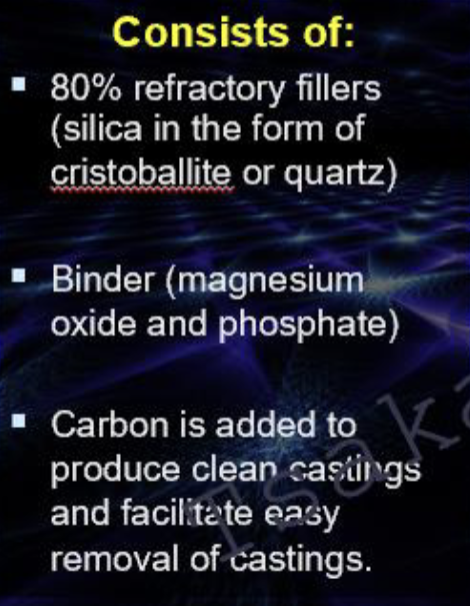
what does this describe?
phosphate-bonded investments
advantages of ethyl-silicate bonded materials?
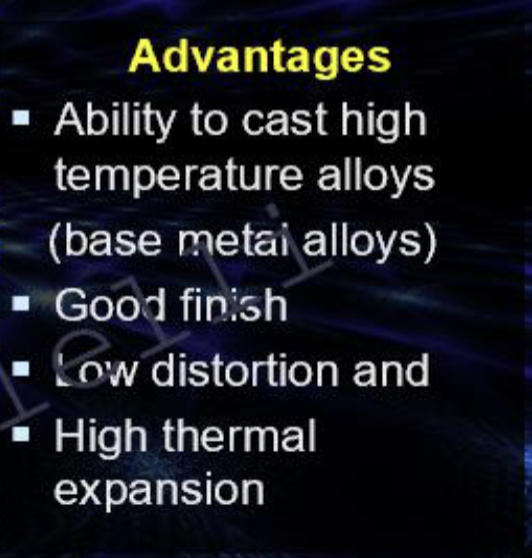

these are characteristics of what investment?
ethyl-silicate
what affects the microstructure and mechanical properties of Cr-Co alloys?
casting temperature
what is used to adjust the alloy due to harness and strength?
high speed laboratory equipment
what is the most common allergic metal known with a 10-20% incidence?
nickel allergy
what is more common in women na d in chronic exposure through jewelry and can be quite severe?
nickel allergy
T or F: nickel ions (Ni+2) are documented to be mutagens in humans and can be carcinogenic intraorally
FALSE
there is NO evidence that nickel is carcinogenic intraorally
T or F: various Ni compounds may contribute to the development of nasal and lung cancers
TRUE
what enhances beryllium release from Ni-Cr alloys?
acidic environment
an analysis of experimental and occupational data indicates that ____ may increase the risk of lung cancer and tumors in max
beryllium
base metal alloys containing _______ revealed a very high leakage which may pose a health risk
both Be and Ni
what is a chronic allergic-type lung response and chronic lung disease caused by exposure, is an occupational lung disease that only occurs in those with a hypersensitivity and is incurable with treatable symptoms?
berylliosis
steps for fabrication of a metal framework
survey master cast, outline partial design
beading
blockout and relief
duplication
refractory cast
waxing
what are the dimensions required for beading?
0.5 mm deep and wide

what type of blockout is C
arbitrary
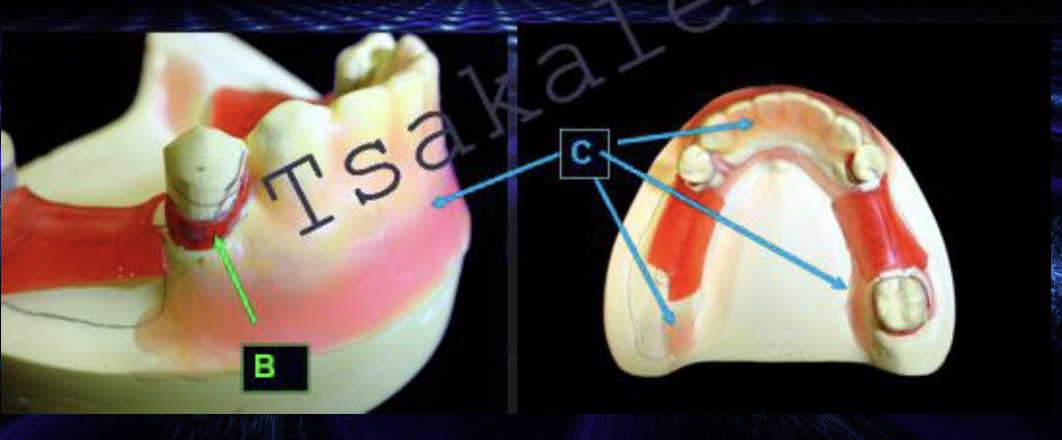
what type of blockout is B
shaped
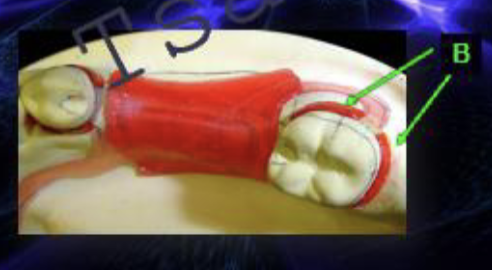
what type of blockout is B
shaped
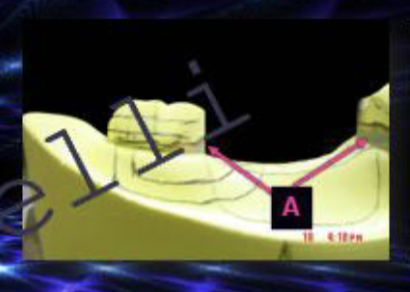
what type of blackout is A
parallel

what type of blockout is A?
parallel
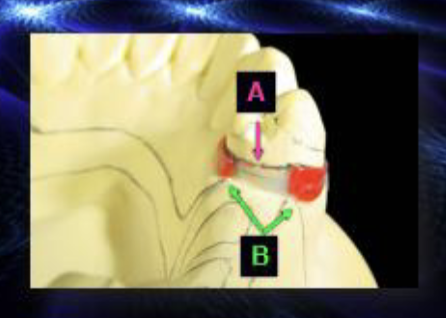
what type of blockout is B?
shaped
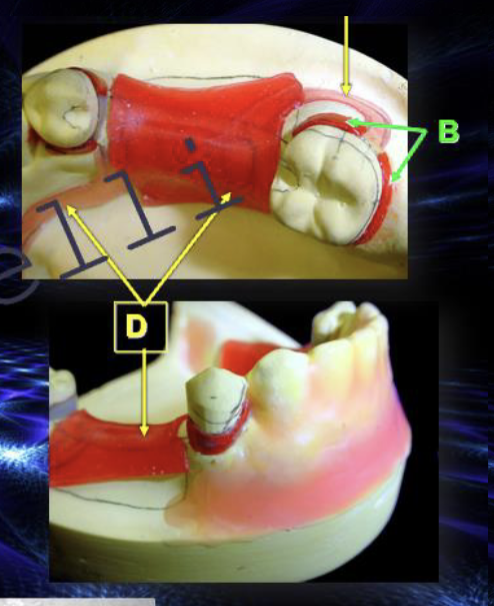
D
relief
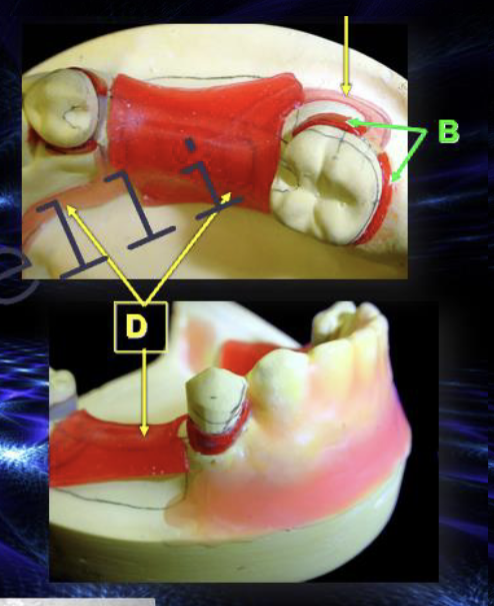
B
shaped blockout
the refractory cast is treated with…
model spray of bees wax
which clasps are cast as part of the framework?
cast alloy clasps
which clasps should be soldered to the framework?
wrought wire
why should excessive heating of the WW clasp be avoided during casting or soldering?
it will cause recrystallization compromising the wire’s mechanical properties
reduced flexibility
WW clasps should be soldered to the framework at some distance from the _____ ______ reducing the likelihood of overheating during the soldering procedure
retentive terminal
how to avoid overheating the WW clasp during soldering?
WW clasps should be soldered to the framework at some distance from the retentive terminal
advantages to WW clasp
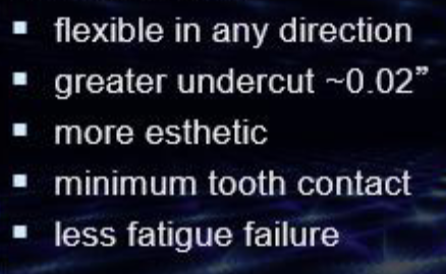
disadvantages to wrought wire

you should examine the metal framework extra orally for what?
presence of defects )bubble, voids, porosities, nodules
continuity
thickness of components
finish lines
polish
location of components
fit
you should examine the metal framework intraorally for what?
complete and stable seating
adaptation
occlusion